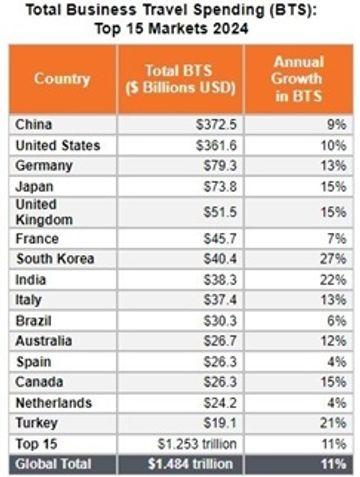GLOBAL REPORT – Citing a stable global economy, the Global Business Travel Association
(GBTA) is now predicting 2024 global business travel spending will reach $1.48
trillion by the end of the year, beating 2019’s previous record of an $1.43
trillion. Additionally, by 2028, it is projected to exceed $2 trillion.
Global business travel spending is anticipated to increase
11.1% in 2024, after significant years in 2022 and 2023 of 30% to 47% growth
year-over-year. Growth is expected to continue to gradually moderate, resulting
in an annual compound growth rate of 6.95% from 2025 to 2028.
While recovery has been impressive, the GBTA said it is
important to note that when adjusted for inflation, spending levels are
anticipated to lag pre-pandemic highs over the coming years, implying that
business travel volumes will remain below pre-pandemic levels as well.
And despite a bullish forecast, the BGTA warned about potential
headwinds such as changing economic conditions, technological advancements and
sustainability challenges. It said persistent inflation, China’s slower
recovery, geopolitical tensions, industry workforce challenges and incidence of
natural disasters could result in shifts to the outlook. Increased
focus on corporate sustainability also has the potential to impact the sector,
demonstrating the vital importance of coordinated action across the industry
for business travel’s future.
Potential upside impacts for the business travel sector
include ongoing economic stability, technological advancements, particularly in
artificial intelligence (AI), and stronger-than-expected economic growth in key
markets like the U.S. and India.
Highlights from the 2024 GBTA BTI Outlook:
- The estimated breakdown of the $1.34 trillion in
2023 business travel expenditures includes $501 billion for lodging, $282
billion for air travel, $245 billion for food and beverage, $165 billion for
ground transportation and $142 billion for other travel expenses. - Recovery in business travel continues to vary by region.
Asia Pacific emerged as the fastest-growing region in 2023 (36%), followed by
Western Europe (33%) and North America (25%). The recovery bounce back was led
in 2023 by the U.S., Middle East and Africa, and Latin America, all achieving
100% or more of 2019 spending numbers. For 2024, China and the U.S. are
forecast to continue to lead as the top two markets, respectively, for overall
business travel spending. - Business travel spending also continues to differ
across industries. The financial and insurance activities sector is
projected to experience the most significant expansion (72%) in
business travel spending through 2028. Conversely, the retail trade (41%) and
agriculture, forestry and fishing (32%) sectors are anticipated to see
the least growth during this period. - GBTA’s survey of 4,100 business travelers across 28
countries and four regions (North America, Europe, Asia Pacific, and Latin
America), revealed an increase in overall business travel, with
international travel remaining below average. Fully, 64% of business travelers
globally report increased spending on business travel compared to 2023.
However, 37% say they have experienced more restrictive travel policies since
pre-COVID. - Business travelers globally estimate their own
spending, on average, amounts to $834 per person based on their last
business trip. Lodging accounts for $312, on average, and food and beverage is
$153. Air travel averages $176 while ground transportation ($103) and
miscellaneous expenses ($89) round out the total. - A majority of survey respondents (81%) reported that their
most recent business trip was very (46%) or moderately (35%) worthwhile in
achieving their business objectives. When asked about their most recent
business trip, the most common purpose of travel among all global
business travelers is attending seminars/training followed by
conventions/conferences. - Two-fifths (40%) of the trips taken are
three-to-five-night stays, while two-night stays account for one-third (32%).
Additionally, 58% said they extended work trips for leisure or vacation about
the same (41%) or more frequently (17%) than previous. - When asked about their greatest priorities while
traveling for work, maximizing comfort (43%) and minimizing cost (41%) are on
the same level globally, with 16% saying reducing carbon emissions.
Additionally, European travelers (22%) are more likely to prioritize reducing
their carbon footprint compared to other regions.





